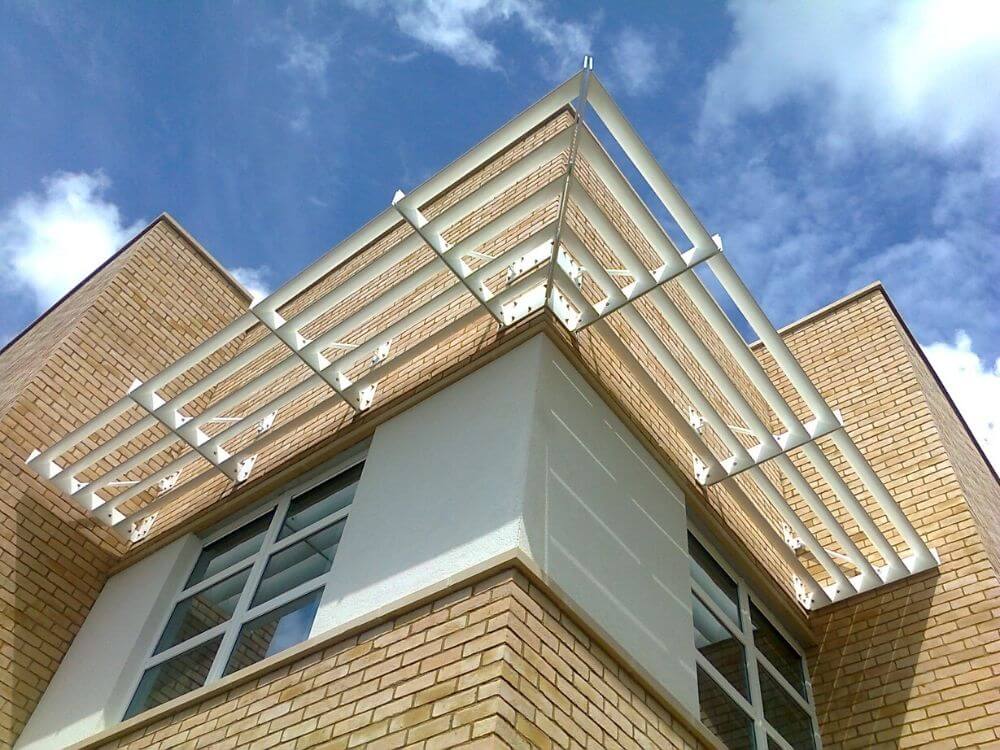Of all the different types of architectural façade and solar screening systems, the one that seems to capture people’s imagination is brise soleil.
What is brise soleil?
- Brise soleil systems protect building from solar gain
- Brise soleil uses angled blades to cut out direct summer sun
Brise soleil is a type of solar shading system that uses a series of horizontal or vertical blades to control the amount of sunlight and solar heat that enters a building.
The name ‘brise soleil’ comes from the French word ‘sun breaker’. The system was developed by the Swiss architect and city planner, Charles Édouard Jeanneret, a pioneer in passive energy control, who first used solar shading on multi-storey buildings in the 1930s.
Brise soleil systems project above glazing to prevent glare and reduce overheating. The blade or fins allow low-level sun to enter a building in the mornings, evening and during winter but cut out direct summer sun, which rises to a maximum angle of 62 degrees in the UK.
Brise soleil systems can be made up of blades or take the form of solid shelves (or even walkways) and are constructed from a range of materials, including aluminium and sustainable wood.
Why are brise soleil systems important?
- Brise soleil systems respond to large areas of glazing on modern buildings
- Brise soleil systems can reduce the ‘greenhouse effect’
Modern architecture for offices, schools, hospitals and many other types of public buildings often feature large areas of glazing to provide more natural daylight, create a feeling of space inside and (potentially) improve the comfort and wellbeing of occupants.
However, controlling the interior temperature of glazed buildings can be a complicated issue. That’s because although the sun can be a useful ally in providing natural light and heat for buildings (reducing energy use and emissions) too much solar radiation can result in glare or over-heading (the ‘greenhouse effect’), which may in turn need to be controlled be energy-intensive cooling. The orientation of a building is also a factor – different elevations will have varying levels of solar gain.
How does brise soleil work?
- Brise soleil systems cut out direct summer sun
- Horizontal blades provide most shading
Brise soleil systems perform a very simple function: to break up the sun’s rays. When positioned above or across windows or glazed building façades, the brise soleil blades cut out direct summer sun, which rises to a maximum angle of 62 degrees in the UK.
Unlike most other architectural features and building products that respond to location, altitude, climate, geology, drainage and human factors, brise soleil systems respond to a simple, never-changing fact of the universe: the sun rises in the east and sets in the west. It travels in an arc, and reaches its highest point in the south (unless you’re in the southern hemisphere).
As a result, brise soleil systems are most effective on south-facing elevations. Here, a horizontal brise soleil blade can provide shade from the worst of the summer sun. It will not provide shade in the winter months, when the arc of the sun is lower ― but this is not considered a major problem as the glare and heat from the sun is lower at this time of the year too. Here, shade is often provided by an internal window blind system.
Horizontal brise soleil ‘shelves’ will not work as well on east or west elevations as the angle of the sun is lower ― sunlight will pass underneath. In these situations, a system that uses multiple vertical blades in front of glazing may be more effective.
Does brise soleil have other functions?
- Not all brise systems have performance benefits
- Brise soleil systems can be used for aesthetic effect
Brise soleil systems are sometimes found on the north elevation of buildings, even though they have few performance benefits.
Why? Because brise soleil systems are also used as architectural ‘art’ to bring the exterior of buildings to life. This is not new: Jeanneret (who worked under the name Le Corbusier) saw the potential to combine the aesthetic and performance qualities of brise soleil in many of his Modernist designs ― although he often used concrete instead of the lightweight aluminium or wood that is used today.
Today, Maple works closely with architects to design brise soleil systems that not only reduce buildings’ operating costs and improve interior comfort, but also look great.
What materials are best for brise soleil?
Most brise soleil systems are constructed in aluminium, but timber (most commonly western red cedar) is still popular.
Aluminium has good strength-to-weight qualities and is used for long spans (6063 T6 is most common but different grades are used for blades that need to be curved or bent).
Timber is heavier and requires more robust fixings, and can therefore add to the total cost. It can be more sustainable (though not as much as one might think), but supply lead times may be longer. Timber brise soleil systems typically fade or weather, which may be part of the design intention, and requires fire retardancy treatment (especially for buildings more than 18m high).
Powder-coating and anodising give aluminium endless design possibilities – it can even be designed to look like timber brise soleil. For the most successful outcome, the final material choice will be determined by a number of variables, and will be the result of collaboration between architect and Maple.
Aluminium Brise Soleil
- Pros: good strength-to-weight qualities, can be fabricated into different shapes, is fire retardant, can be coated for different effects
- Cons: Volatility of price, considered less environmentally friendly, can appear stark and ‘unnatural’
Timber Brise Soleil
- Pros: a natural product that can add ‘character’ to architecture, weathering can enhance design effect, seen as more sustainable
- Cons: heavy and requires more robust fixings, can be difficult to work with (eg, knots and imperfections), long supply lead times, requires fire retardancy treatment, weathers and fades, total costs can be high
What next?
For more information about brise soleil, or for help and advice on Maple’s range of solar shading systems, contact one of our project consultants.





